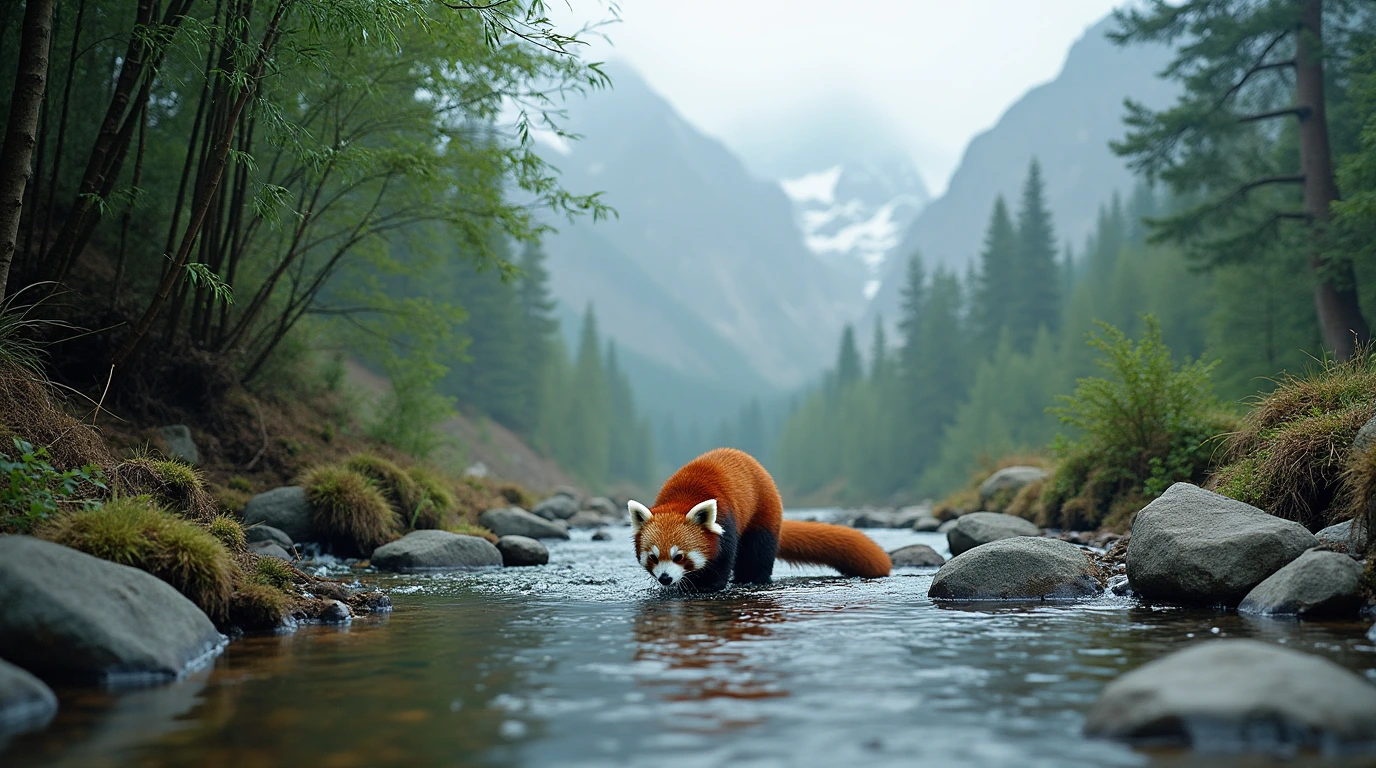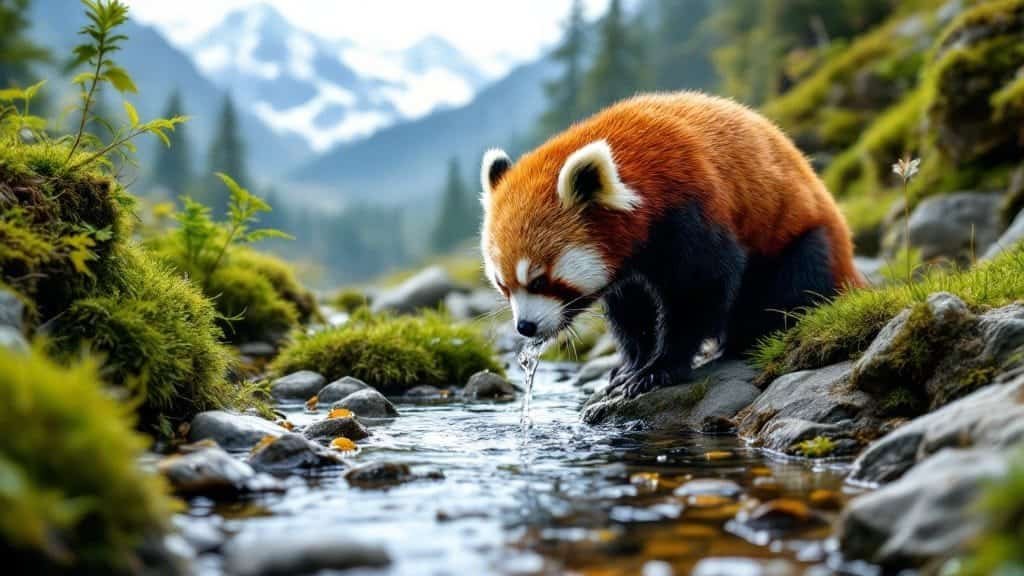Red pandas, native to the misty forests of the eastern Himalayas and southwestern China, rely heavily on access to water for their survival. Living at elevations between 7,200 and 13,800 feet, these arboreal mammals face a challenging environment where hydration is just as critical as food and shelter. Unlike some mammals that can obtain most of their water through food, red pandas actively seek out natural water sources, making proximity to streams and snow-fed brooks a vital part of their habitat selection
These small mammals inhabit dense temperate forests where frequent rainfall, melting snow, and steep terrain create a network of perennial water sources. Red pandas often position their home ranges close to streams and rivulets, minimizing the energy needed to hydrate and reducing their exposure to ground-based predators
In this article, we’ll explore the types of water sources red pandas use, how they incorporate water access into their daily routines, and how climate change and habitat fragmentation threaten these critical resources. Understanding how red pandas stay hydrated sheds light on their broader survival strategies and the delicate balance of their high-altitude ecosystems
How Red Pandas Find and Use Water in High-Altitude Forests

Red pandas are uniquely adapted to life in the steep, forested slopes of the eastern Himalayas and parts of southwestern China, regions that offer both dense vegetation and vital access to freshwater. Their survival depends not only on a reliable bamboo supply but also on a consistent water source, which they strategically incorporate into their daily routines and territory selection
Common Water Sources in Red Panda Habitats
The high-altitude temperate forests where red pandas live are characterized by their rugged terrain, rich biodiversity, and an abundance of natural water features. These areas typically include fast-flowing mountain streams, narrow brooks, and snowmelt-fed rivulets that weave through steep valleys. These freshwater sources are sustained by seasonal monsoon rains and melting snow from surrounding peaks, creating a reliable hydration network throughout the year
Unlike many other species that can travel great distances for water, red pandas choose habitats that place water within close reach of their feeding and resting sites. Research published in PubMed Central emphasizes that microhabitat selection among red pandas is strongly influenced by the presence of nearby streams, with many individuals limiting their home range to areas that offer easy access to fresh water
This spatial strategy not only conserves energy but also reduces the time they spend exposed on the forest floor, where predators like martens and wild dogs may pose a threat
Importance of Water Proximity for Red Panda Survival
Hydration is critical to the red panda’s physiology, particularly because of its low-calorie, bamboo-rich diet. Bamboo contains very little water, especially the mature leaves that make up the bulk of their winter diet. While red pandas can obtain some moisture from fresh shoots and seasonal fruits during warmer months, they still require direct water intake to support digestion, maintain internal temperature, and perform daily metabolic functions
Their small body mass and high surface-area-to-volume ratio mean red pandas lose moisture more quickly than larger mammals, especially in the dry mountain air. By staying near water sources, they avoid the physical stress and caloric cost of traveling long distances to hydrate. Proximity to water also supports the growth of bamboo and other vegetation they rely on for food, creating a habitat where their nutritional and hydration needs can be met simultaneously
The Smithsonian’s National Zoo confirms that red pandas show a strong preference for cool, moist environments—specifically those with evergreen trees, dense undergrowth, and water nearby. These conditions provide not only the resources for survival but also the structural complexity needed for hiding and resting
Drinking Frequency and Hydration Behaviors
Though red pandas are elusive and difficult to observe in the wild, field studies and observations from wildlife sanctuaries suggest that they drink water regularly, especially after feeding sessions. They tend to use the same paths and access points to approach streams, minimizing the risks associated with ground movement. These water stops are often located in shaded, low-visibility areas of the forest, providing cover while the panda hydrates
In captivity, red pandas have been observed drinking several times a day, and similar behavior is presumed in wild individuals, especially during warmer periods or after consuming dry bamboo leaves. Their hydration routine is tightly woven into their daily activity schedule, which includes foraging during dawn and dusk and resting in treetop hollows or dense canopy layers during the day
Red pandas’ close relationship with water is an example of how habitat design and resource availability directly shape the behaviors and survival strategies of forest-dwelling mammals. By integrating hydration into their core territory design, red pandas reduce risk, conserve energy, and ensure that their daily needs are consistently met
Hydration Strategies and Habitat Preferences

In the mountainous forests of Asia, red pandas exhibit behavior and habitat preferences that are closely aligned with the availability of freshwater. These hydration strategies are critical for an animal with a high dependence on low-moisture foods like bamboo and a limited ability to store water. Their survival depends on efficient access to clean water with minimal energy expenditure and risk
Water Intake from Food vs. Direct Consumption
While red pandas can obtain some hydration from their diet—particularly during spring and early summer when bamboo shoots are rich in moisture—this source is insufficient year-round. Bamboo leaves, which constitute the bulk of the red panda’s diet during much of the year, contain significantly less water. In fact, the water content of mature bamboo leaves drops dramatically as the plant ages and dries during the winter months
Supplemental foods such as berries and soft fruits consumed during the summer offer a temporary boost in hydration. However, these items are seasonal and cannot be relied upon as a primary water source. As a result, red pandas consistently require direct access to fresh water sources like mountain streams and brooks, which they actively seek out as part of their daily routine
The combination of direct drinking and limited dietary hydration reflects their ecological adaptation to living in areas where snowmelt and rainfall ensure year-round water availability. Even so, this dependence makes them vulnerable to fluctuations in water source stability due to environmental changes
Energy-Efficient Movement to Water Sources
Red pandas conserve energy by establishing home ranges that are spatially optimized around water availability. Rather than making long, frequent journeys to hydrate, they settle in territories where streams run close to their sleeping sites and bamboo feeding grounds. This strategic choice minimizes physical exertion and reduces the need to traverse open ground, which increases exposure to predators
They typically descend from trees to drink, selecting low-traffic, shaded areas along the forest floor where they can remain concealed. Because they tend to use the same routes repeatedly, their movement is not only energy efficient but also tactically familiar, enabling them to detect changes in their environment or avoid known hazards
Path fidelity—sticking to familiar, efficient routes—combined with a compact home range ensures that red pandas can maintain hydration without deviating far from their core habitat. This behavioral strategy is vital given their solitary lifestyle and relatively low metabolic rate, which limits their ability to sustain prolonged or intense physical activity
Optimal Elevation Zones with Reliable Water Access
Red pandas are most commonly found between 7,200 and 13,800 feet (2,200 to 4,200 meters), an elevation range that offers both suitable vegetation and reliable water availability. These elevations experience seasonal snowfall, which feeds into glacial streams and small brooks throughout the year, particularly during spring thaw and summer rains
Within this altitude range, red pandas show a strong preference for forested areas with steep slopes and valleys—terrain that naturally channels water flow and supports bamboo growth. As noted in PubMed Central’s ecological studies, these areas also provide the structural complexity needed for safety and nesting
Forests dominated by fir, rhododendron, and hemlock often overlap with the densest bamboo thickets and highest stream densities, offering the best combination of shelter, food, and water. These zones serve as hydration hubs for red pandas, allowing them to maintain a balanced physiological state in an otherwise rugged environment
Environmental Threats to Red Panda Water Sources

As climate patterns shift and human encroachment expands into red panda territory, the availability and stability of freshwater sources in high-altitude forests face mounting threats. These environmental changes not only impact hydration access but also disrupt the broader ecological balance that supports red panda survival.
Climate Change Impact on Water Availability
One of the most significant threats to red panda hydration is climate change. Rising global temperatures are affecting precipitation patterns, altering the timing and quantity of snowfall, and accelerating glacial melt in the Himalayan regions. This disrupts the seasonal flow of streams that red pandas rely on for year-round hydration
In areas where snowmelt-fed streams have historically run through red panda habitat, warmer winters and less snowfall can result in reduced or dried-up watercourses by late spring or summer. The early loss of these freshwater sources forces red pandas to either travel longer distances in search of hydration or compress their range closer to the few remaining streams, increasing stress and competition
According to long-term ecological assessments, such as those reviewed in PubMed Central, areas experiencing greater climate variability show declining red panda presence, correlating with the disappearance of stable water networks and degraded bamboo growth linked to drought and temperature extremes
Habitat Fragmentation and Stream Depletion
Human-driven deforestation, agricultural expansion, and infrastructure development are fragmenting the red panda’s forest habitat, often severing access to essential water sources. Roads, settlements, and grazing land can interrupt stream flow, divert water from panda habitat, or pollute previously clean water supplies
In regions where logging or land clearing occurs near ridgelines or stream beds, sediment runoff and erosion can clog small brooks and reduce water quality. This not only limits hydration options but also harms the bamboo and other plant species that depend on consistent moisture, affecting food availability in tandem with water loss
Habitat fragmentation also prevents red pandas from easily relocating to better-watered areas. Natural movement corridors are disrupted, creating isolated pockets of habitat where water may be scarce or inconsistent, making it harder for populations to remain viable long-term
Conservation Needs for Hydration and Ecosystem Stability
To protect red pandas’ access to water, conservation efforts must prioritize preserving and restoring natural stream networks within their forest habitat. Maintaining riparian vegetation and ensuring watershed health is critical, as these ecosystems naturally filter water, prevent erosion, and support bamboo growth
Protected areas and wildlife corridors must be designed to include year-round water sources, enabling red pandas to move safely between zones and access hydration without increased exposure to human activity or predators. Organizations such as WWF and the Red Panda Network are working with local communities to safeguard watershed regions and reduce logging and land conversion in key habitats
Public awareness and policy development are also crucial. Sustainable land use, climate-resilient forestry practices, and funding for habitat restoration can help stabilize water access and mitigate the longer-term impacts of a changing climate. Ensuring that red pandas have continuous, safe access to clean water is not just a matter of survival—it’s central to the health of the entire mountain forest ecosystem they support and depend on













